Axolotls are some of the most fascinating aquatic herps around and make a great addition to a display tank. But if you’re looking to add plants to your display, you need to think things through because axolotls and plants don’t always mix…
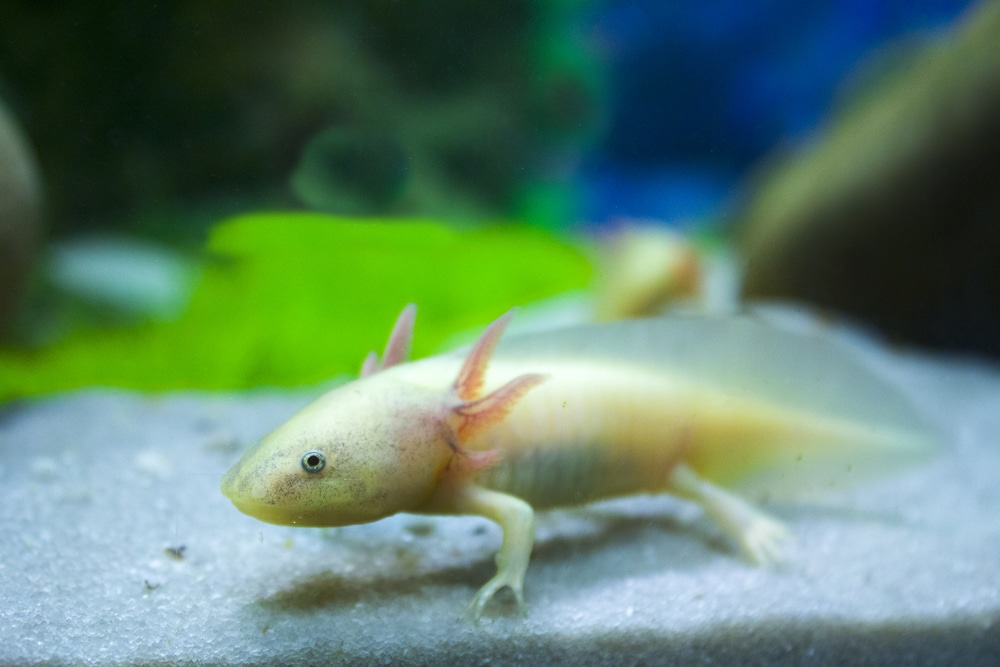
Live versus Artificial Plants for Axolotl Tanks
When setting up an axolotl tank, you should take some time to consider how you’re going to aquascape. In particular, will you use life plants or artificial ones? As it turns out, both have significant advantages to consider.
Live plants are undeniably more work. As living organisms themselves, they have nutrient and lighting needs that may not align with your setup. In particular, axolotls thrive in cooler temperatures and low light conditions that make the majority of aquarium plants a poor match for them. That said, I’ve identified quite a few below that will thrive alongside your axolotl and provide benefits like ammonia removal.
Plastic and silk aquarium plants are popular with axolotl keepers because they need no maintenance whatsoever! Many also look extremely realistic and are less expensive than many live options. You can simply plop them into the substrate and walk away. That said, they don’t provide oxygen for your aquarium residents, nor do they integrate into your biological filtration system.
In short, there are reasons for choosing both live and artificial plants. So think about how much work you’re willing to take on, the benefits of both kinds, and choose accordingly!
Choosing Plants for an Axolotl Tank
Axolotls and plants can be hard to match to one another. But with a bit of planning, you can find plants that will not only survive but thrive alongside your axolotl!
Why are Axolotls Hard on Aquarium Plants?
Axolotls are difficult tank mates for live plants for several reasons. For one, they grow quite large: up to 18 inches. 9 to 12 inches is more common but this still makes them sizable, clumsy residents for most tanks. Axolotls will simply push through dense plant growth, which means that any plants that are loosely fixed to the substrate will be readily uprooted. Plants hate being uprooted and this will kill the majority of them over time.
Lastly, they prefer low light levels, while plants usually prefer as much light as you can offer. And axolotls need to be kept cool (60-74℉), while most aquarium plants in the trade are tropical and prefer a range of 70-82℉.
Floating Plants
Of all the plant types you can choose from for your axolotl tank, floating plants are by far the best! They help reduce direct overhead lighting and provide dappled, natural looking shade, which the sometimes secretive axolotls prefer.
Floating plants also tend to be fast-growing because they have access to unlimited carbon dioxide from the air and are right next to the light. Since they grow quickly, floating plants lock up loads of ammonia, nitrites, and nitrates, all pollutants for animals but fertilizers for plants. Lastly, they aren’t subject to being disrupted by your axolotl as it crawls around the bottom, looking for food.
Epiphytes
Epiphytes are another category of plants that do especially well in axolotl tanks. Epiphytes refers to plants that attach to hard surfaces rather than root themselves in sand or gravel. Since these plants can be easily blown or washed away in nature, they tend to have sturdy holdfasts that resist dislodging by even the most determined aquarium residents.
Epiphytes tend to be slower growing since they don’t have the root surface area and access to unlimited nutrients that traditionally growing plants do. But this slower growth means that they are also far less demanding than rooted plants for nitrogenous fertilizers, carbon dioxide, and lighting. This makes them ideal for aquariums that don’t have proper plant lighting or CO2 generators added.
Choosing Rooted Plants
Rooted plants are those that remain fixed within a sand or gravel substrate. By the way, you should always keep an axolotl on a sand substrate, never gravel. They have very poor vision and tend to snap up and swallow anything that comes in range of them. If they get a mouthful of food and gravel, they will often swallow all of it at once. Gravel can cause intestinal blockages that are fatal to them – so only provide sand, which can be safely expelled by an axolotl!
Of the three categories of plants listed here, plants attached to the substrate are the most vulnerable to being uprooted by an axolotl determined to find food. However, you can choose plants that form dense webs of roots that, once established, will resist being uprooted easily. Just remember that rooted plants tend to be more demanding than floating plants or epiphytes when it comes to lighting, fertilizer, and carbon dioxide.
The 10 Best Plants for Your Axolotl Tank
Here are a few of the best plants for Axolotl tanks:
Hornwort
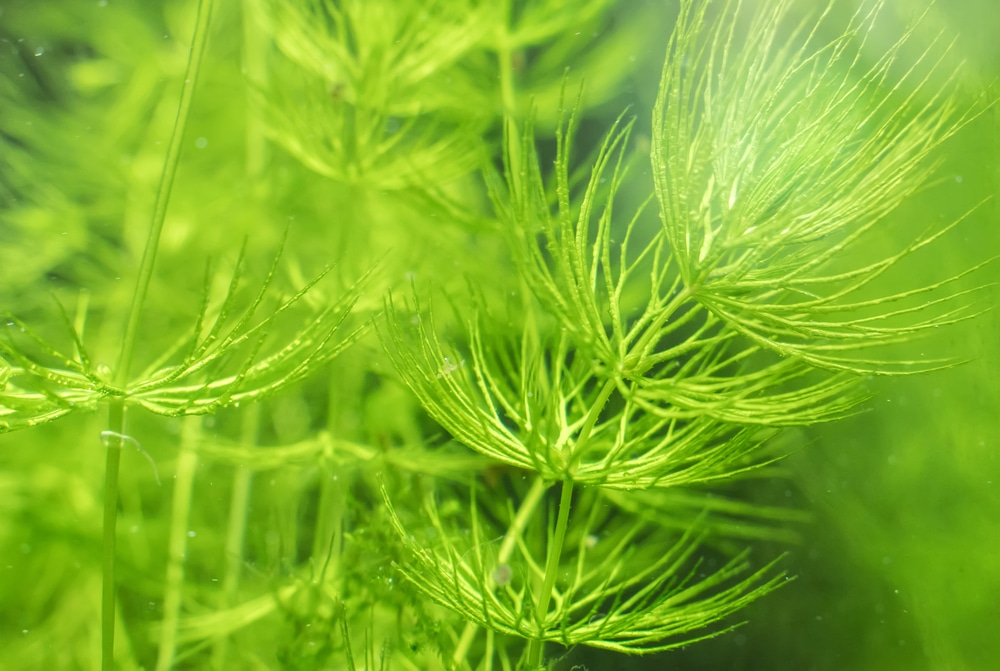
Hornwort has been an aquarium staple for decades. This fast growing plant is found in temperate regions throughout North America, Europe, and Northern Asia. One of the best qualities of Hornwort is that it can be grown as either a floating or rooted plant. When rooted it has a delightful, bushy growth habit that lends itself to being used anywhere a midground or background plant would look good.
But you can also allow a bunch of Hornwort to simply float around the tank. It will form a dense web of stems near the surface and it may even flower if the lighting is intense enough. While it has a messier look than many other floating plants, it’s hard to beat Hornwort for ease and sheer versatility!
- Scientific Name: Ceratophyllum demersum
- Type of Plant: Rooted & Floating
- Size: Up to 6 feet
- Ease of Care: Very Easy
Java Fern
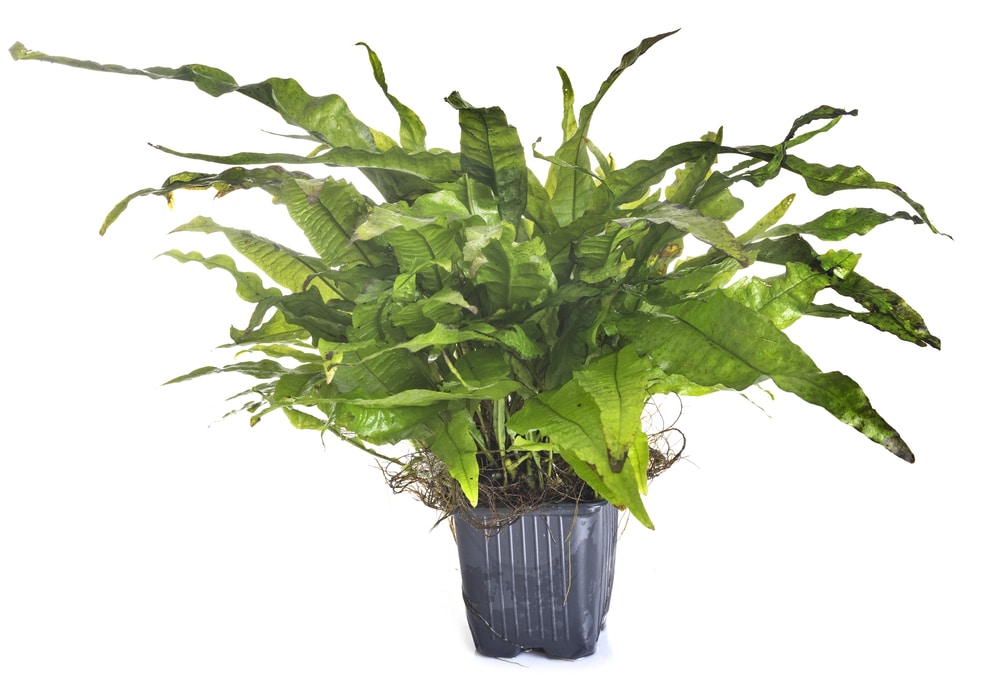
Java Fern is another long-time aquarium staple that’s popular with aquarists that prefer low tech setups (no CO2 or specialized plant lighting). This plant typically prefers tropical conditions rather than the cooler room temperature water that axolotls do. However it will still grow, just even more slowly than it typically does.
Java Fern comes in an assortment of varieties, some of which are dwarfed and others that grow up to 16 inches in height. The majority have a deep green coloration that makes it an excellent fit for tanks with driftwood and rocks where the plant will slowly attach to and grow over them. Java Fern is an ideal low light plant and doesn’t grow much more quickly even when provided with abundant light and nutrients.
Java Fern reproduces by creating tiny plantlets on the tips of its leaves, which eventually break free of the mother plant. You can spread it by attaching these plantlets or just dividing the rhizome and gluing each piece to a new section of the tank!
- Scientific Name: Microsorum pteropus
- Type of Plant: Epiphyte
- Size: Up to 16 inches
- Ease of Care: Very Easy
Java Moss
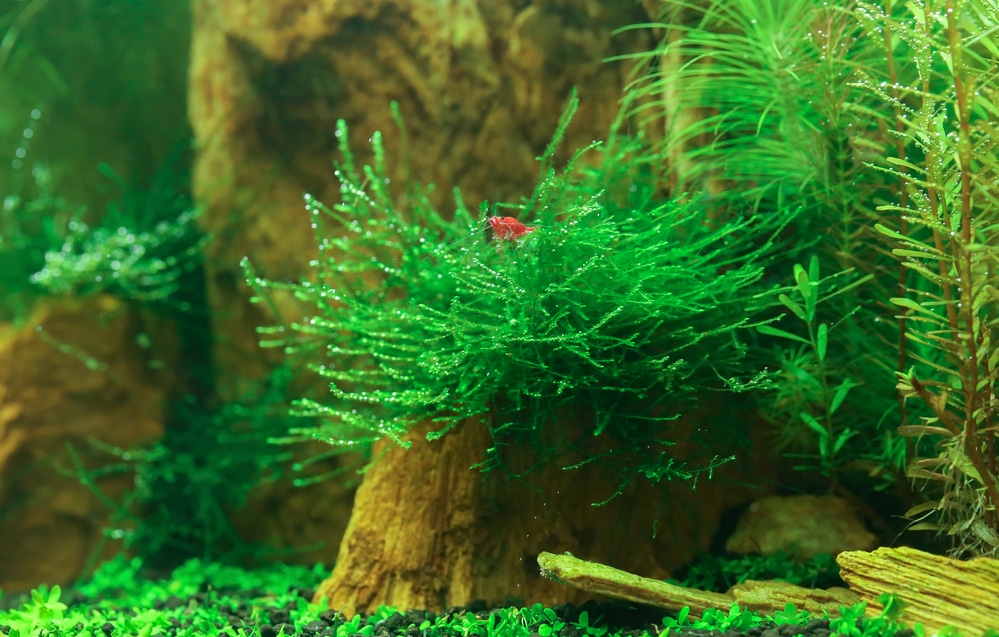
Java Moss is another versatile plant similar to Hornwort. In this case, you can grow it as either a floating plant or epiphyte. Since Java Moss forms especially messy tangles when allowed to float freely, I recommend using string or glue to attach it to hard surfaces so it creates a swamp or forest aesthetic in your tank!
Java Moss is one of the most durable plants around, even more so than Hornwort! It thrives in a wide range of water conditions, temperatures, and lighting conditions. Providing it with warmth and strong light will cause it to grow that much faster but even in the cool confines of an axolotl tank it will thrive. Java Moss is also an excellent nutrient sponge, soaking up loads of ammonia that the carnivorous axolotls create with each bowel movement.
- Scientific Name: Vesicularia dubyana
- Type of Plant: Floating & Epiphyte
- Size: Up to 4 inches tall
- Ease of Care: Very Easy
Red Root Floater
Red Root Floater is becoming very popular in the hobby as a classier alternative to the fast growing but invasive duckweed. It’s actually a species of floating, aquatic fern and while it does form mats that can easily cover the entire surface of your tank, the larger individual plants allow you to keep it readily under control. It’s also constantly in demand so you’ll find ready customers among friends and local pet stores!
Red Root Floater is an excellent sponge for ammonia and other waste products and is extremely attractive. When placed under bright lighting, both the roots and leaves take on a delicate pink blush and you may even see tiny white flowers! Since axolotls prefer dim conditions you can allow your floaters to spread across the entire surface while your salamander prowls in the depths for a true swampy aquascape.
- Scientific Name: Phyllanthus fluitans
- Type of Plant: Floating
- Size: Up to 2 inches across; 4 to 6 inches long
- Ease of Care: Very Easy
Sweet Potato Vine
Sweet Potato Vines are actually a terrestrial plant and are the same species as edible sweet potatoes that you might find at the grocery store. The ornamental variety is hardier and has more attractive leaves but you can sprout culinary potatoes as well, if you wish. Once placed in the water, the “potato” or a piece of potato can be sprouted. Over time, it will grow roots on the submerged section and leaves from the dry portion
The trick is to secure the potato in such a way that it is only partially submerged. There are tons of YouTube videos on ways to pull this off! Eventually, the roots will need trimming because they will spread all throughout your tank.
And the upper leaves are beautiful but do need some supplemental lighting from a nearby window or light fixture. Sweet Potato Vines also live up to their name as they have long runners that they send in all directions so you’ll need to train them up a wall or support. Or simply keep them well trimmed!
- Scientific Name: Ipomoea batatas
- Type of Plant: Rooted (special)
- Size: Several feet
- Ease of Care: Easy to Intermediate
Sagittaria
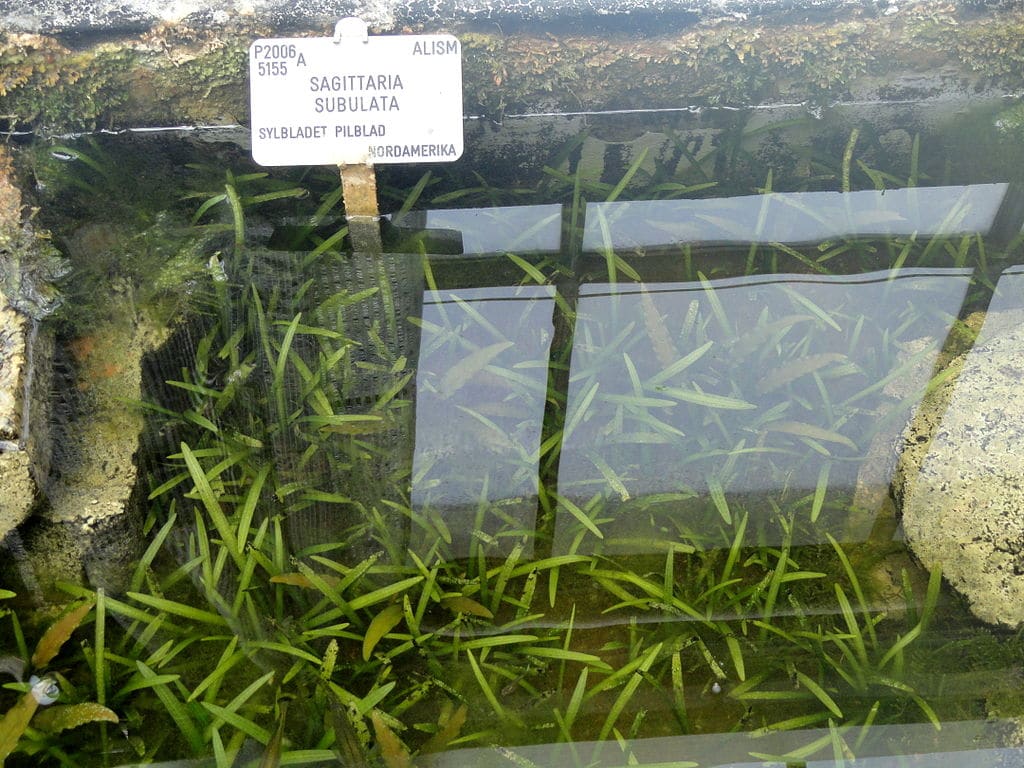
There are a number of species of Sagittaria, from the popular Dwarf Sagittaria (Sagittaria subulata) to a Giant variety and other species. They are similar to Eelgrass (Vallisneria sp.) in appearance except Sagittaria tend to have broader leaves with rounded tips. They also aren’t quite as lanky or tall, preferring to form squat clumps.
Sagittaria are also some of the best plants for beginners or aquarists with a brown thumb. In fact, they can be somewhat invasive, quickly spreading to cover the bottom and crowding out other plants. FOrtunately, they are quite beautiful, with a vibrant light green tone. Sagittaria do need moderate to high lighting but don’t require much else. Just make sure that your axolotl has places to retreat to when it feels exposed. Sagittaria are also robust enough to weather an axolotl pushing its way through the grassy meadows it forms!
- Scientific Name: Sagittaria sp.
- Type of Plant: Rooted
- Size: Variable
- Ease of Care: Easy to Moderate
Duckweed
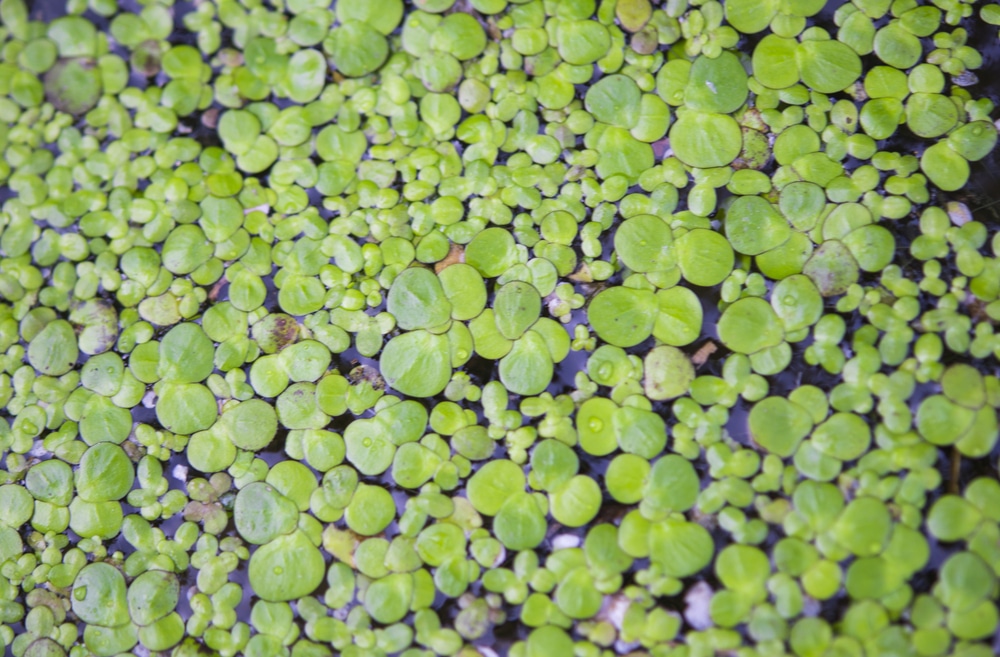
Duckweed can be a boon or a pest, depending on your point of view. It’s probably the absolute easiest aquarium plant to grow in the world. As a floating plant, it stays close to the surface, drinking in light and carbon dioxide. Duckweed is a fantastic nutrient sponge as well, helping to purify the water and prevent algae by providing plenty of shade.
But it’s ability to multiply from a single specimen can make it almost impossible to get rid of once you add it to your tank. You need to be sure that you really want duckweed because you may have to break your tank down to get rid of all of it. That said, axolotls will love the murky conditions it can create for the bottom of your tank!
- Scientific Name: Lemnoideae family
- Type of Plant: Floating
- Size: 2mm
- Ease of Care: Very (too) Easy
Anubias
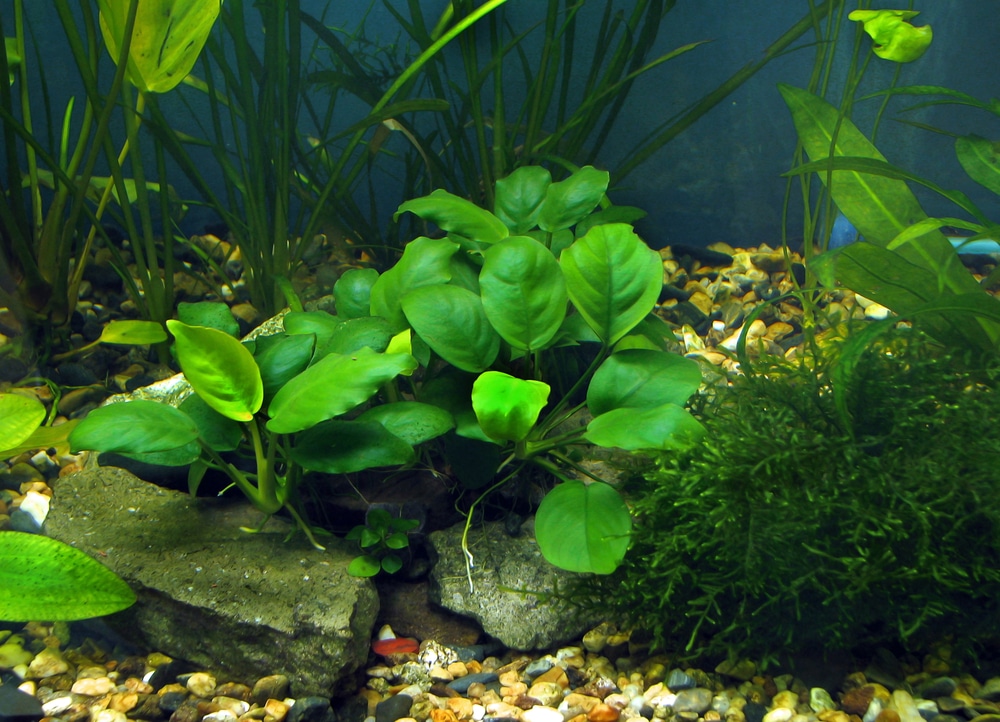
Anubias are a favorite of aquarists all over because they are some of the most durable plants you can purchase. They grow extremely slowly even in the best of conditions. But they have a dark green hue that never disappears unless they are doing extremely poorly. Anubias are low light plants and epiphytes, so you should attach them to rocks and other hard surfaces.
There are quite a few species and cultivars of these popular African plants but they are all easy and attractive plants for an axolotl tank. Anubias do prefer being kept warm, so keep things lightly heated so both they and your axolotl thrive!
- Scientific Name: Anubias sp.
- Type of Plant: Epiphyte
- Size: 1 to 24+ inches
- Ease of Care: Easy
Amazon Frogbit
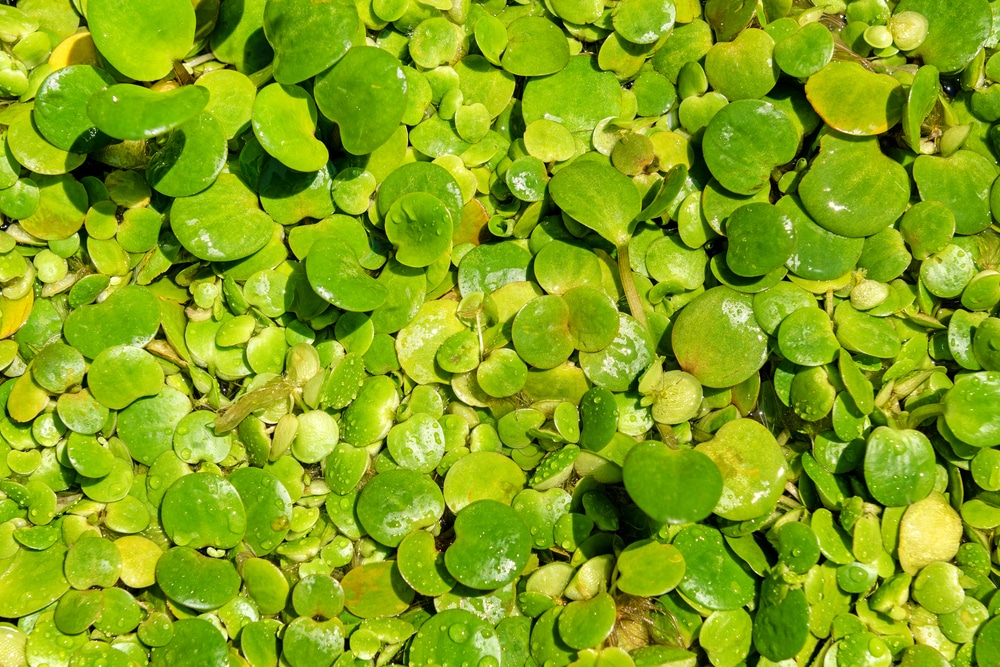
Amazon Frogbit is another floating fern that’s related to Red Root Floater, only with a much tidier appearance. They have coin or teardrop shaped leaves but can also form thick underwater root masses that stretch down into the depths. This species grows extremely quickly but is also much easier to handle than duckweed.
Red Root Floater does provide a bit of extra color and white flowers. But if you prefer the jungle green of duckweed but want the option to remove it at your leisure, Amazon Frogbit is a great alternative!
- Scientific Name: Limnobium laevigatum
- Type of Plant: Floating
- Size: 1 inch across; 4 to 6 inches long
- Ease of Care: Very Easy
Marimo Moss Ball
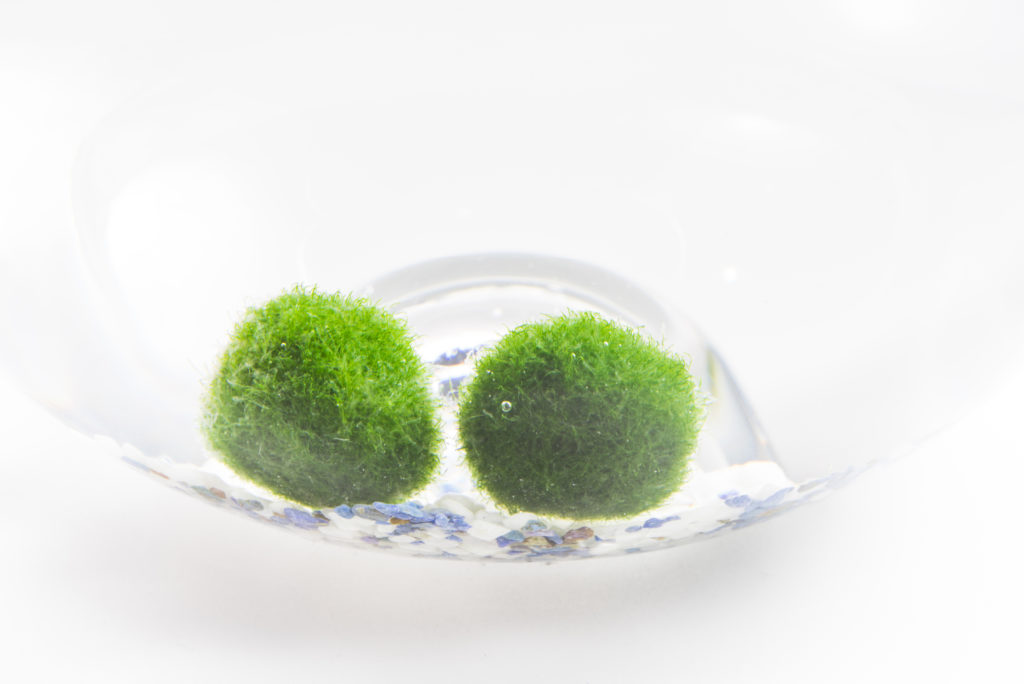
This last plant may come as a surprise to many aquarists but Marimo Moss balls will thrive alongside axolotls because they have similar care requirements. Marimo Moss balls are found near the bottom of chilly lakes in Japan and Northern Europe. It’s actually not a moss but a rare ball growth formation of coldwater algae that grows in a circular fashion.
The coldwater part is very important because most moss balls you find in stores slowly wither as they are kept in tropical conditions. Like axolotls, Marimo Moss prefers unheated, even chilled conditions. Moss balls are fine with moderate to low lighting and actually demand low fertilizer levels because they grow slowly enough that nuisance algae can form on their exterior in rich conditions.
- Scientific Name: Aegagropila linnaei
- Type of Plant: Special
- Size: 2 to 6 inches in diameter
- Ease of Care: Difficult

